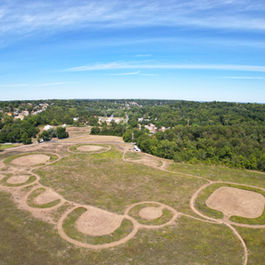Widely regarded as one of North America's premier backpacking trails, the Cirque of the Towers loop in Wyoming's Wind River Range treats hikers to non-stop views of towering granite peaks and spires, high alpine lakes, and vast boulder-strewn meadows. The trail's highlight is its namesake, Cirque of the Towers, a stunning semi-circle of fifteen 12,000-foot craggy peaks resting along the Continental Divide. With breathtaking views around every bend, Cirque of the Towers deserves a spot on every backcountry enthusiast's bucket list.


Trailhead elevation 9,089'
Water abundant throughout
Don't miss camping at Lonesome Lake and taking a swim at Shadow Lake
Big Sandy Trailhead to Lonesome Lake
From the Big Sandy Trailhead, the trail initially traces the Big Sandy River for 0.5 miles before reaching a clearly marked junction. Here, hikers can choose to turn left to follow the Continental Divide Trail clockwise, or veer right to follow the Big Sandy Trail counterclockwise. The description below follows the clockwise route. After 3.3 miles through a forested area, the trail opens up to a vast meadow scattered with boulders, offering views of Mount Geikie (12,378'), Mount Bonneville (12,590'), Mount Hooker (12,509'), Pyramid Peak (12,033'), and other distant peaks.

After crossing the meadow for approximately 1.4 miles, the trail runs alongside the western shore of Mirror Lake, the first of eleven alpine lakes along the route.

Continuing 0.8 miles beyond Mirror Lake, around the 5.5-mile mark, the trail follows the eastern shore of Dad's Lake. For those preferring not to filter water directly from the lake, the nearby Donald Creek, located near the northern end of the lake, offers a reliable source. Donald Creek and all subsequent stream crossings along the loop are easily managed with simple rock hopping.

At around the 7-mile mark, the trail skirts the western shore of Marms Lake. During wildflower season, typically from mid-July to mid-September, the lake is surrounded by prairie bluebells, adding a nice touch to an already gorgeous view.

Approaching the 10-mile mark, the trail crosses Washakie Creek, with Washakie and Bair Peaks rising dramatically to the north. As the trail continues eastward, the backside of the jagged peaks belonging to Cirque of the Towers come into view, including Wolfs Head (12,185'), Sharks Nose (12,234'), Overhanging Tower (12,169'), and several others.

After a third creek crossing, the trail briefly passes through a shaded forested area, one of the few along the route to this point, before reaching Shadow Lake near the 11.5-mile mark. Shadow Lake is widely considered one of the most scenic spots on the hike, offering stunning views of the backside of Cirque of the Towers and some of the best backcountry camping options along the route. Those who wish to spend multiple nights in the backcountry might consider a night here.

As the trail follows the northern shore of the lake, glimpses of Elizabeth Peak (11,844') appear briefly to the south.

Around the 12.7-mile mark, the trail reaches Billys Lake and follows its northern shore. As the trail ascends from Billys Lake, hikers who look back are treated to a beautiful view of Elizabeth Peak and the northeastern shore of Billys.

Within half a mile of Billys Lake fading from view, the trail reaches Barren Lake, immediately followed by Texas Lake. At Texas Lake, Camels Hump (12,528') dominates the skyline. Near the southern shore of Texas Lake, around the 13.7-mile mark, lies a large boulder field and the beginning of the challenging ascent up Texas Pass. This section, widely considered the crux of the hike, involves a steep climb over loose scree with grades reaching up to 60%. Hikers must tackle an intense 700 feet of elevation gain over just 0.3 miles to reach the high point of the route.

As the top of Texas Pass becomes clear, looking back offers a stunning view of both Texas and Barren Lakes below.

At 11,447 feet, the top of Texas Pass offers hikers what may be the most stunning view yet. Looking southward, hikers can enjoy views of Cirque of the Towers, including Pingora Peak (11,889'), the Warrior Peaks (12,411') and Warbonnet Peak (12,192'). Jackass Pass can be seen across the valley to the south as well.

After navigating a year-round snowfield at the top of Texas Pass, hikers are met with a nearly 1,300-foot descent over the next mile, filled with loose scree.

Although less steep than the northern approach to Texas Pass, the descent can be equally tiring, with the trail occasionally seeming to vanish into thin air. However, as the trail continues to lose elevation, the views become more and more beautiful.

As hikers make their descent, they will come across a long stream flowing from east to west. Since the water in Lonesome Lake is considered unsafe for drinking due to contamination from human waste, it's recommended to filter water from this stream before reaching the lake. Around the 15-mile mark, the trail arrives at the northwest corner of Lonesome Lake. A short half-mile walk to the lake's eastern shore rewards hikers with stunning views of the Cirque—a breathtaking panorama of jagged peaks and spires towering over 12,000 feet above the lake's picturesque waters.

The peaks to the west of Lake Lonesome, listed from left to right, are Warbonnet, Warrior 1, Warrior 2, Watch Tower, Block Tower, Shark's Nose, Overhang Tower, Pylon, Bollinger, Pingora, and Wolf's Head Some of the peaks are obscured by Pingora Peak but become visible as the hike continues up Jackass Pass later on.

Camping is prohibited within a quarter-mile of the lake, so hikers must find a campsite beyond the southern shore. Those who hike from Big Sandy Trailhead to Lonesome Lake in a single day can expect to accumulate 3,000 feet in elevation gain over the course of 15.5 miles.
Lonesome Lake to Big Sandy Trailhead
From Lonesome Lake, the trail climbs over 600 feet in half a mile up Jackass Pass, offering spectacular views of the Cirque, including peaks hidden behind Pingora Peak.

After reaching Jackass Pass, the trail descends to Arrowhead Lake, aptly named for its shape.

To the south, framed by granite walls on either side, Temple Peak (12,977') looms in the distance.

Hikers will encounter a challenging section as they navigate rock slabs and boulders along the eastern shore of Arrowhead Lake. Entering the scramble with an expectation that the pace will rapidly decrease is appropriate. Beyond the Arrowhead Lake, the trail continues through a boulder-strewn landscape, gradually descending to North Lake.

At North Lake, the trail follows the western shore but becomes increasingly difficult to follow. To stay on course, hikers should keep to the higher ground.

After North Lake, the trail traverses vibrant wildflower fields as it heads south.

Around the 19.5-mile mark, after a series of switchbacks, the trail reaches Big Sandy Lake. As the largest lake on the route, Big Sandy is surrounded by Schiestler Peak (11,592') and features a striking skyline of East Temple Peak (12,605'), Temple Peak (12,977'), and Haystack Mountain (11,978') to the southeast.

From Big Sandy Lake, the trail descends gradually through a mix of open spaces and forested terrain before arriving at the Big Sandy Trailhead, approximately 25.5 miles from the start. Those who opt to camp at Lonesome Lake and finish the hike in two days can expect to accumulate 900 feet in elevation over the course of 10 miles during the second day.
_edited.png)






















